The 7 Movements your need to Master - Part 3: Hinge and Twist
Part 3: Hinge and Twist (just not at the same time).
If you haven't already, start with Part 1 here.
Today we discuss Part 3: the Hinge and the Twist.
5. Hinge
The hinge movement is essentially folding at waste. This is one of the most prevalent movement patterns in our day to day life. Everything from tying your shoes to climbing into the car requires you to bend at the waste. Most people have a faulty hinge pattern, and instead of hinging at the hips (the proper mechanics), they use their back. This is a prevalent factor in the frequency of back pain. To train the hinge, perform movements like Good Mornings, Deadlifts and Straight Leg Raises. If you find that you are flexing or extending your back, instead of your hips, use exercises such as Bird Dogs, Dead Bugs and Hollow Body Holds to develop proper torso control.
Here are the things you need to remember when training the hinge:
Keep you back flat
Load your hips and glutes first by using your hips to start the movement
Only work within the range that you can keep your back flat. Slowly increase your range over time as you develop the stability
6. Twist
The "Twist" movement pattern category is about both your ability to twist and your ability to resist rotation. Proper torso rotation is an even distribution of twist throughout the torso, with minimal twisting coming from your lower back. Many people have hypermobile lower backs and very limited mobility in their upper back. Our bodies are designed for the opposite, and we rely on our lower back for stability and our upper back for mobility.
Another important job of our torso is to resist rotation. Most of the movements that we do are unilateral (i.e. one side of the body performs different movements than the other). All of these unilateral movements cause rotational forces, which our torso needs to deal with. If it didn't we wouldn't be able to run, walk or carry odd objects.
To improve your twist, keep these tips in mind:
Improve your T-Spine (i.e. upper back) mobility
Squeeze you glutes during all twisting movements (this helps to stabilize your lower back)
When trying to improve your stability, try these exercises and follow these tips:
Lunges, Pallof Presses, Bird Dogs and Farmers Carries are some of my favorite exercises for developing core stability
Squeeze your glutes (same reasons as above....)
Mastering the hinge and the twist can help keep you out of pain and prevent injury. They are worth spending the time on, but often get neglected.
In the next article we talk about our last movement pattern: Running (Gait)
-Mark
B.Kin, Canadian Society of Exercise Physiology CPT

